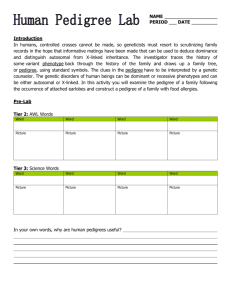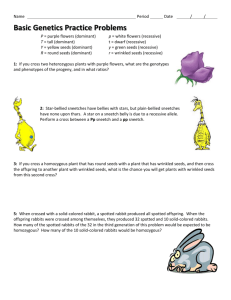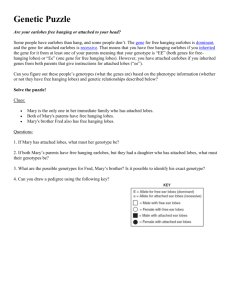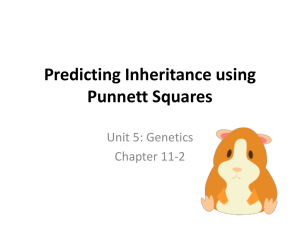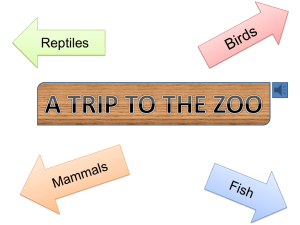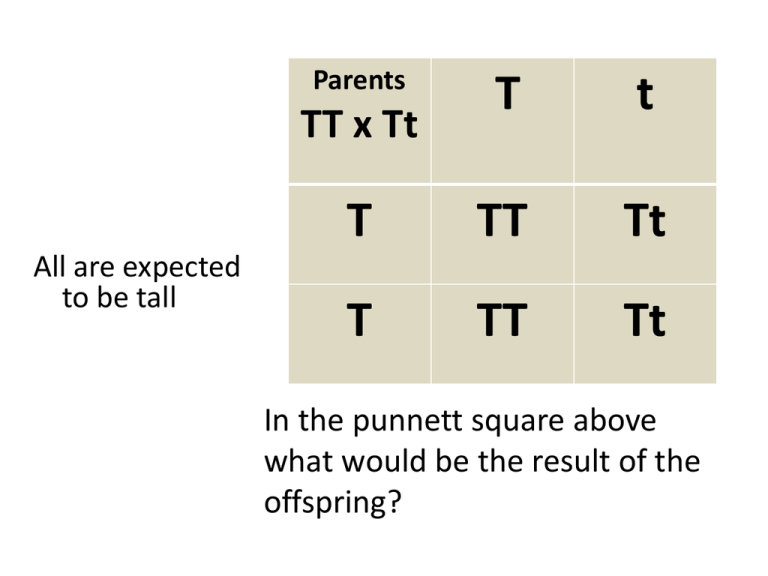
Parents
T
t
T
TT
Tt
T
TT
Tt
TT x Tt
All are expected
to be tall
In the punnett square above
what would be the result of the
offspring?
Independent
assortment
A male and female
bison that are
heterozygous for
normal skin Aa
pigmentation
produce an albino
offspring aa which
Mendel’s principles
explains why the
offspring in albino?
What is shown below?
Crossing Over
Four cells
Different
Unlike mitosis,
meiosis results in
the formation of
how many cells
and are they
identical or
different?
Whether a trait is
inherited
How treats are
passed from one
generation to the
next
Determine
dominant and
recessive alleles
A pedigree can be
used to determine
what?
C
Which of the following
genotypes result in the
same phenotype?
A. I^A I^A and I^A I^B
B. I^B I^B and I^A I^B
C. I^B I^B and I^B i
D. I^B i and ii
They usually
have some
normal
hemoglobin in
their red blood
cells
People who are
heterozygous
for sickle cell
disease are
generally
healthy
because?
The allele for
colorblindness is
recessive and on
the X
chromosome.
In terms of sex
chromosomes X and Y .
Males and females have
what chromosomes?
Colorblindness is more
common in males than in
females because?
Cure genetic
disorders
The purpose of
gene therapy is to?
C
Climate is a global factor
that produces?
A. Earths ocean and
atmosphere
B. Shape and elevation of
landmasses
C. A wide range of
environmental conditions
that shape communities.
D. Solar energy within the
atmosphere.
Greenhouse
Effect
Temperature on
Earth remains
within a suitable
range for life as
we know it
because of?
Cancer
Decrease resistance
to disease
Damage eyes
Overexposure to
UV radiation can
cause?
Global Warming
An increase in
Earth’s average
temperature
from buildup of
carbon dioxide
and other gases
in the
atmosphere is
called?
The major cause of ozone
depletion is?
Chloroflourcarbons
Limited Supply
( cant make more)
Why are fossil fuels
nonrenewable?
B
According to Darwin’s theory of
natural selection, individuals who
survive are the ones best adapted
for their environment. Their survival
is due to
A. Possession of adaptations
developed through use.
B. Possession of inherited
adaptations that maximize fitness
C. Lack of competition within
species
Interbreeding among members of
a population results in
No change in the relative
frequencies of alleles in the gene
pool
The two main sources of genetic
variation are
Gene shuffling
Mutations
In a population of finches in which one
group of birds has a short, parrot like
beak and another group has a long,
narrow beak, what process has
probably occurred?
A.
B.
C.
D.
Directional selection
Disruptive selection
Stabilizing
Genetic drift
B
Which factor would most likely disrupt
genetic equilibrium in a large
population?
A. The production of large numbers of offspring
B. Mating that is not random
C. The absence of movement into and out of
the population
D. The absence of mutations
B
A factor that is necessary for the
formation of a new species
Reproductive isolation
Geographic isolation
The first organisms on Earth were
most like today’s
Bacteria
A single species that has evolved into
several different forms that live in
different ways has undergone
Adaptive
Radiation
What does the presence of similar
genes in very dissimilar organisms
imply?
Share a common ancestor
Some scientists propose that kingdom
protista should be broken up into
several kingdoms. Which of these
statements accurately supports the
idea.
A. Protists are all very similar and easy to
confuse
B. Protista contain very diverse organisms
that do not fit into the other kingdoms
C. Protista evolved before any other
kingdom
B
Compare and Contrast
Explain on a lined piece of paper
why daughter cells produced by
meiosis are genetically different
from each other, whereas the
daughter cells produced by mitosis
are not.
(hint: use diagrams on wall)
The pedigree shows the inheritance of free
earlobes and attached earlobes in five
generations of a family. Attached earlobes are
caused by recessive alleles.
Is individual 2 homozygous or
heterozygous for free earlobes?
Explain.
The individual is heterozygous (Ff),
since her daughter has attached
earlobes. The daughter inherited one
allele for attached earlobes from
individual 2 and another from
individual 1.
How many children of
individuals 4 and 5 have
attached earlobes?
None of those children have
attached earlobes.
Can you be certain of the genotype
of individual 5? Explain.
No, the genotype of individual 5 is
uncertain because his children have free
earlobes. Thus, individual 5 could be
homozygous (FF) or heterozygous (Ff) for
free earlobes. If, however, one of his
children had attached earlobes, it would
be certain that individual 5 was
heterozygous.
Predict the genotype and phenotype
of individual 14.
Individual 14 will be homozygous
for the recessive allele (ff) and will
have attached earlobes.
Are any of the descendants of
individuals 1 and 2 homozygous for
free earlobes?
No, none of the descendants are
homozygous (FF) for free earlobes.
Examine the graph above. It charts the yield of a
farm over several years. In 1975 a pesticide was
applied for the first time. It was reapplied in 1980 at
the same dosage and in 1990 at twice the original
dosage. In 1995, a new pesticide was applied.
Provide an explanation for the pattern shown by
the metric tons?
Comparison of Two
Vertebrates
Characteristics Shark
Dolphin
Habitat
ocean
ocean
Type of
vertebrate
Composition of
skeleton
fish
mammal
Respiration
breathes
in water
cartilage bone
breathes in
air
Charles Darwin would say that sharks like
the one on the previous slide exhibit
fitness. Explain what that means, and
discuss two specific adaptations as part of
your explanation.
(1) Sharks have an overall body shape that
enables them to move rapidly through water.
(2) Sharks have a large tail and fins that
provide balance and enable them to steer. (3)
Sharks have teeth that make them successful
predators.
Evidence indicates that dolphins evolved
from ancestors that walked on land. How
can the concept of natural selection be
used to explain the evolution of the
present-day dolphin body?
The dolphin’s land-dwelling ancestors were
probably made up of populations with different
body shapes and limbs. Those land-dwellers began
to spend more time in the ocean, perhaps because
food was easier to find. In each generation, those
with bodies that moved efficiently in water survived
longer and produced more offspring than others.
Eventually, the whole population came to resemble
today’s dolphins.
Sharks and dolphins, which belong to
different vertebrate groups, are not
closely related. How can Darwin’s ideas
about evolution help explain such a
similar appearance?
Darwin proposed that over time, natural
selection made a population more fit for
its environment. Sharks and dolphins
both live in the ocean, where natural
selection favors organisms that move
efficiently through water.
If you wanted to find out whether sharks
and dolphins share homologous
structures, what structures would you
examine? Explain.
Although their skeletons are made of
different materials, there are likely to be
homologous structures in the skull,
backbone, and limbs. There may also be
homologous structures among internal
organs such as heart, brain, and digestive
system.
Suppose a dolphin population becomes
trapped in a harbor that is growing
smaller and more shallow because of
climate changes. Is it likely that the
dolphins would evolve into a landdwelling species in a few thousand years?
Explain your answer.
It is not likely: (1) Darwin emphasized that
evolution usually requires millions, not
thousands, of years. (2) The bodies of dolphins
are well adapted to life in water, with little
observable variation; it’s unlikely that the
population’s relevant characteristics could
change in just thousands of years.
Background Information:
You are assigned to participate in a conservation
project in Brazil located near the equator. The
climate is wet usually 60 to 80 inches of rain per
year. There are a large amount of organisms that
live in the tropical environment. Two-thirds of
Earth’s animal and plant species are found in a rain
forests. The rain forest environment consist of tall,
broad-leaved evergreen trees that form a leafy
canopy, as a result, there is restricted undergrowth
in rain forests because lack of sunlight at ground
level. The food resources are dispersed due to high
diversity in the region.
You arrive in Brazil to study the various species
in this environment. One particular population
in the rain forest, iguanas. They possess the
following characteristics, sharp, clawed feet;
thick, leathery skin; greenish-brown color; long
tail; finely-serrated teeth; thick, slightly-forked
tongue; and very good eye sight. They live high
in the canopy but can spend long periods of
time under water. They are classified as a
omnivore. It lays between 20 and 70 eggs at a
time in warm moist soil. These eggs undergo a
3 month incubation period.
Year
Co2 Concentration
1750
275
1800
280
1850
287
1900
303
1950
310
2000
382
1. Given the environment, explain what evolutionary factors
contributed to at least 5 of the characteristics.
2. Utilizing the chart and graph to infer what human activity
could have contributed to the rise in carbon dioxide in the
atmosphere
3. How might this activity directly affect the population of
iguanas in addition to the rain forest itself?
4. If the atmosphere continues to change at its current rate,
what adaptations must occur for the iguanas to become
better suited for their new environment?

